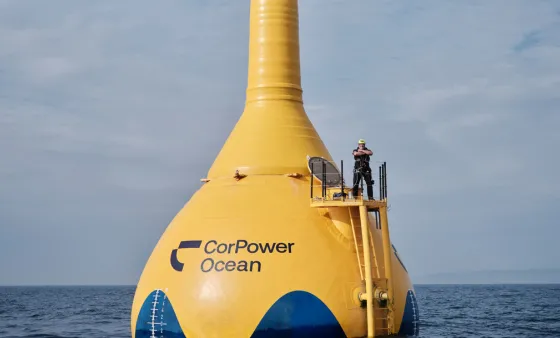A new wave energy technology is making waves—literally. CorPower Ocean’s innovative system, the CorPower C4, is redefining what’s possible in the realm of marine renewables. With early deployments showing stunning results, this could mark a turning point for wave power and its long-overdue place in the global energy mix.
The Untapped Power of Waves
Wave energy has long been a mystery in the renewable sector—immensely powerful, yet largely unexploited. Despite its density and predictability, wave power remains the most underutilized renewable resource.
To understand its potential, consider this:
Estimated global wave energy potential is around 29,500 terawatt-hours (TWh) per year.
Global electricity consumption in 2023 was roughly 28,000 TWh.
In theory, wave power alone could satisfy—or even exceed—our current electricity needs. And unlike solar or wind, waves are far more predictable. They carry 5–10 times more energy per square meter than wind, and over half the global population lives within 100 km of a coastline, making access relatively easy.
So Why Has Wave Energy Lagged Behind?
The ocean is a brutal environment. Saltwater corrosion, violent storms, and marine life fouling have crippled earlier wave energy projects. Mechanical linkages often failed under pressure, and attempts to reinforce them led to higher inertia—reducing energy conversion efficiency.
In the 1970s, the Salter’s Duck showed promise in lab conditions, converting over 90% of wave energy into electricity. But scaling that into real-world ocean conditions proved a far greater challenge.
Wave power lost momentum as solar and wind technologies matured rapidly, backed by lower capital costs and quicker deployment times. Still, innovation continued.
Learning from the Past: The Rise and Fall of Pelamis
In the 2000s, the Pelamis Wave Energy Converter—with its unique snake-like design—captured global attention. It was the first wave energy project to achieve grid connection in 2004 and saw deployments in Scotland and Portugal.
Yet despite its promise, Pelamis struggled with funding and technical durability, and the company dissolved in 2014. The lesson was clear: survival at sea is just as important as energy generation.
CorPower C4: A Game-Changer in Wave Technology
Enter CorPower Ocean, a company that’s taken those hard-earned lessons and turned them into a new generation of wave power.
Their flagship technology, the CorPower C4, uses a point absorber system—a deceptively simple-looking buoy that’s anything but basic.
- Dimensions: 9 meters wide, 18 meters tall
- Core Technology: A unique “negative spring” mechanism that allows it to resonate with ocean waves, amplifying motion and maximizing energy output
- Rated Output: ~300 kW
- ⚖️ Energy Efficiency: Delivers 5x more energy per tonne than earlier designs—sometimes reaching over 10 MWh per tonne
But what truly sets the C4 apart is its survivability. During extreme weather, it automatically detunes to become “transparent” to waves—relaxing tension in the tether and reducing impact loads by up to 90%.
Tested in the Real World
Since September 2023, CorPower C4 has been operating off the coast of northern Portugal. During Storm Domingos, the system endured waves over 18.5 meters high, confirming its storm-mode capabilities.
Its outer hull is crafted from glass-reinforced plastic (GRP)—a corrosion-resistant composite designed for extreme oceanic stress, slamming impacts, and long-term fatigue.
Building the Future with Existing Infrastructure
The C4 system is also designed for modular deployment—making it ideal for wave farm arrays and compatible with existing offshore wind infrastructure. This reduces installation costs and allows hybrid renewable systems to flourish.
Currently, deployments are underway in Scotland and Portugal, with more likely to follow.
Toward a Bluer, Greener Future
CorPower Ocean’s C4 represents a bold vision for marine energy: compact, durable, and highly efficient. If this technology proves cost-effective at scale—and if it continues to gain support from investors and policymakers—it could finally usher wave power into the mainstream.
The future of renewables might not just be in the wind or sun—but in the ceaseless rhythm of the sea.
